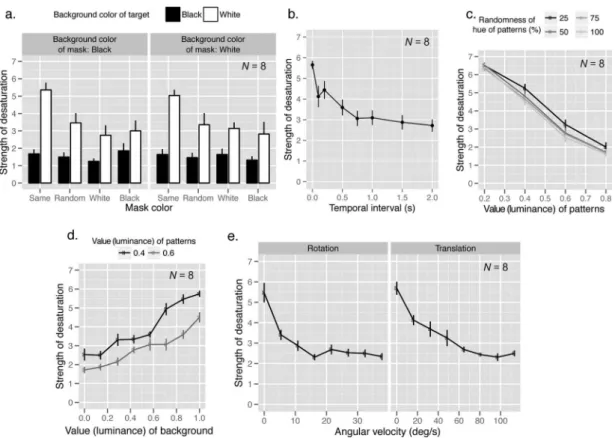a Pion publication
i-Perception (2013) volume 4, pages 144–146
dx.doi.org/10.1068/i0584sas ISSN 2041-6695 perceptionweb.com/i-perception
Kohske Takahashi
Research Center for Advanced Science and Technology, the University of Tokyo, 4-6-1, Komaba, Meguro-ku, Tokyo 153-8904, Japan; e-mail: ktakahashi@fennel.rcast.u-tokyo.ac.jp
Shun’ya Yamada
School of Science, the University of Tokyo, 7-3-1, Hongo, Bunkyo-ku, Tokyo 113-0033, Japan; e-mail: shunyayamada@chem.s.u-tokyo.ac.jp
Fuminori Ono
Faculty of Education, Yamaguchi University, 1677-1, Yoshida, Yamaguchi-shi, Yamaguchi 753-8513, Japan; e-mail: fuminori@yamaguchi-u.ac.jp
Katsumi Watanabe
Research Center for Advanced Science and Technology, the University of Tokyo, 4-6-1, Komaba, Meguro, Tokyo 153-8904, Japan; e-mail: kw@fennel.rcast.u-tokyo.ac.jp
Received 18 January 2013, in revised form 15 April 2013; published online 2 May 2013.
Abstract. When two images, one depicting colored disks and the other depicting colored windmill patterns, are displayed in succession, the color of the windmills is perceptually replaced by black. The illusion is striking. Experiments conirmed (1) that the luminance contrast between the target patterns and the background must be large and (2) that the disks and windmills must be static on the retina and in register. The illusion is weakened when the windmills and disks have different colors.
Keywords: optical illusion, desaturation, color vision.
Optical illusions demonstrate how complicated human color vision is. We cannot see the color of a surface as is. Color is not a property of the surface but a result of neural processing by the brain. Here, we report a novel optical illusion wherein chromatic windmills are perceptually replaced by black when presented in succession with chromatic disks (Figure 1, online demonstration: http://www. fennel.rcast.u-tokyo.ac.jp/CAS_illusion/).
We studied some characteristics of this illusion as follows. (1) The illusion was strong when the background of the windmill was bright (Figure 2a). (2) The disks and windmills had to have the same color, otherwise the illusion was weak (Figure 2a). (3) The desaturation was maximized when the windmills appear immediately after the disks without temporal gap (Figure 2b). (4) The illusion strongly depended on the luminance of the windmills and their background, while it depended only weakly on the hues in the pattern (Figures 2c and d). Dark patterns and bright backgrounds led to the stronger desaturation. (5) The illusion critically depended on the retinal position between disks and windmills; when the retinal position of the images got out of register during stimulus movement, the illusion was much weaker if present at all (Figure 2e).
The other characteristics based on our personal observation are that (7) the shape of target other than the windmill, e.g., concentric circle or random dots, can induce the illusion, as long as the back-ground region weaved into the igure, and (8) the smaller masks relative to the windmills appear to decrease the illusion, which suggests that the masks need to cover the whole region of the windmills. These phenomena can be experienced with the online demonstration.
Perceptual desaturation itself is not a novel phenomenon. The saturation of a surface is perceived as lower when it is surrounded by a chromatically variegate pattern (gamut expansion effect; Brown & MacLeod, 1997; Ekroll, Faul, & Wendt, 2011). When a color pattern is viewed for a while, the satura-tion of the pattern will decrease (desaturasatura-tion by adaptasatura-tion; De Valois & De Valois, 2000; Hurvich,
1981). However, these phenomena are experienced only either by comparison to reference stimuli or by seeing negative afterimages. The illusion we found is far more powerful to the extent that observers report no color of the windmills at all.
SHORT AND SWEET
145 Takahashi K, Yamada S, Ono F, Watanabe K
Figure 1. Schematic illustration of the illusion. The mask consists of a regular array of colored disks and the target of equally colored windmill patterns in the same places (top). When the target and mask images are displayed in alternation, observers perceive the windmills as desaturated in color and ultimately uniformly black, while the color of the disks remains unchanged (bottom).
Copyright 2013 K Takahashi, S Yamada, F Ono, K Watanabe
Published under a Creative Commons Licence a Pion publication
Loss of color by afterimage masking 146
The illusion would consist of multiple mechanisms. The afterimage masking due to color adap-tation process (Geisler, 1978; Hurvich, 1981; Rinner & Gegenfurtner, 2000) is one candidate of the underlying mechanisms of the illusion. The illusion was weak when the windmills and masks had different colors (Figure 2a). In the illusion, observers see a negative afterimage of the masks at the background region weaved into the windmills. In the same color condition, the colors of the negative afterimages are competitive with the colors of the adjacent windmill. The presence of complementary colors may enhance the suppression of chromatic signals originating from the windmills and there-fore may reduce their visibility. Furthermore, the temporal gap between the target and mask images decreased the illusion (Figure 2b), which strongly suggests the involvement of the adaptation process.
The illusion is strong and robust. Although the proposed accounts are incomplete and a large part of the underlying mechanisms is still open, since the loss of color for the chromatic pattern is subjec-tively observable, it will be useful tool to investigate how the subjective color appearance emerges in our brain.
Acknowledgments. This work was partially supported by CREST, JST, Japan, and KAKENHI, JSPS/ MEXT, Japan.
References
Brown, R. O., & MacLeod, D. I. (1997). Color appearance depends on the variance of surround colors. Current Biology, 7(11), 844–849. doi:10.1016/S0960-9822(06)00372-1
De Valois, K. K., & De Valois, R. L. (2000). Color vision. In K. De Valois (Ed.), Seeing (pp. 129–176). San Diego, CA: Academic Press.
Ekroll, V., Faul, F., & Wendt, G. (2011). The strengths of simultaneous colour contrast and the gamut expansion effect correlate across observers: Evidence for a common mechanism. Vision Research, 51(3), 311–322.
doi:10.1016/j.visres.2010.11.009
Geisler, W. S. (1978). Adaptation, afterimages and cone saturation. Vision Research, 18(3), 279–289.
doi:10.1016/0042-6989(78)90162-1
Hurvich, L. M. (1981). Color vision. Sunderland, MA: Sinauer.
